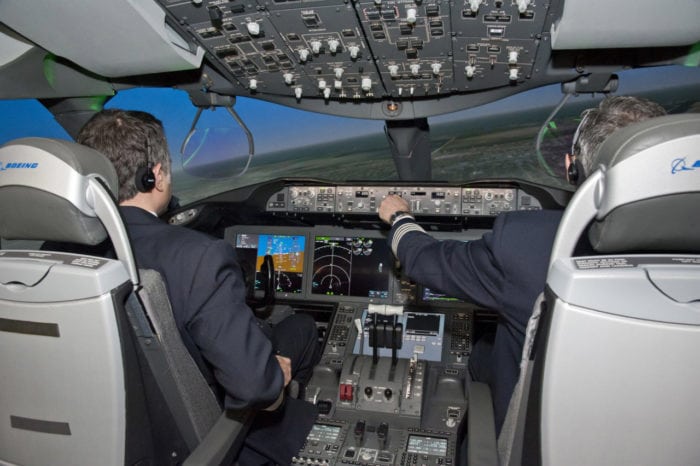
Boeing 787 simulator. Photo courtesy of Boeing
On the third day of the Paris Air Show, Boeing did something that it typically does not do: an in-depth public presentation on advanced aircraft technologies it is currently researching. Mike Sinnett, VP of product development for Boeing Commercial Airplanes, said one of the world’s largest commercial airframe manufacturer’s future research focuses on three areas — autonomous taxi and flight control technology, machine learning and high-integrity systems.
During the show, Boeing released an updated current market outlook, which projects demand for 41,030 aircraft over the next 20 years, creating a market worth $6.1 trillion. While this presents a healthy market for Boeing and its competitors, Sinnett also noted that Boeing is considering a need for increasing the level of autonomy and machine learning within passenger-carrying aircraft in a more advanced way than the autonomy featured on Boeing passenger-carrying aircraft today.
According to Sinnett, the project market demand creates a need for not only newer and more fuel-efficient aircraft, but also for pilots — 617,000 of them. The Boeing executive said there is a concern from Boeing that there are not enough new pilots in training today to fulfill that need, which could lead to a future possibility where there simply aren’t enough pilots to operate all of the aircraft on all of the flights that airlines and operators are flying 20 years from now.
The major challenge for Boeing in terms of increasing levels of autonomous avionics and other technologies in passenger carrying jets is being able to ensure the same levels of safety in passenger flight operations that are available today. To put that in perspective, Sinnett’s presentation featured statistics on automotive fatalities, which have increased by 14% since 2014 to 40,000 fatalities in 2016. Several automotive manufacturers are currently researching self-driving cars to combat this statistic. Comparatively, there were no deaths that occurred on scheduled air transportation flights last year.
Therefore, Boeing is looking at how to safely introduce increased levels of autonomy safely, in a way that would match the levels of safety that have already been established in the industry today. According to Sinnett, one of the first autonomous capabilities that Boeing is exploring is focusing on an autonomous taxi system. He said that Boeing is currently researching autonomous taxiing technology at airports in the Puget Sound region of Seattle, and he outlined the challenges and specific technologies it needs to master to make it a reality.
“We have to figure out how to provide the airplane information to provide the information that the airplane needs to understand where it is and where everything is around it. That means you have to have a significant amount of sensor fusion in there. Visual sensors, fused with data on the airplane, ADS-B In information, [Traffic Collision Avoidance System] info, combined with own-ship info and visual cues with a camera system all integrated together,” said Sinnett, adding that Boeing is preparing for demonstrations of autonomous taxi system technology in the next two years.
Machine learning is another autonomous technology that Boeing is researching right now as well. The focus around machine learning is a major shift in thinking for Boeing and commercial airplanes, which primarily feature deterministic systems that act in a one input/one output structure.
Currently, Boeing’s research and development division has inserted a machine-learning algorithm into its flight simulators that is focused on making flight operational decisions and learning from the outcomes of each of those decisions. He said as the algorithm continues to learn about decisions progressively, it would eventually be ready to control an actual airplane.
“We will have that algorithm on an airplane next year operating in an unclosed loop environment, just understanding the decision what the machine made and what that decision would have led to on the actual airplane,” said Sinnett.
The team Sinnett is leading is also trying to increase its understanding of the role pilots play in an aircraft from a safety perspective. He said that their assumption about faults that occur in aircraft avionics, along with fault responses and failure mode effects where a flight crew steps in to keep something bad from occurring, is a specific focus.
One example is an aircraft that has an autopilot engaged, flying straight and level at a cruising altitude of 35,000 feet and suddenly, for no reason at all, the autopilot turns the aircraft slightly. When this occurs, a pilot would typically step in, disconnect the autopilot and then reconnect it, making it work accurately for the remainder of the flight. That flight crew then typically would report that fault to Boeing, which would report it to the FAA and then try to figure out why it happened.
Some of these concepts such as machine-learning algorithms and autonomous taxiing capabilities could be featured on the next two Boeing Eco Demonstrator programs, with a 777 planned for 2018 and a 787 planned for 2019 as Boeing continues to use the Eco Demonstrator as it has in the past for researching advanced concepts.
“We’re already planning the 2019 work, which will return to the 787, and the bulk of that work will be related to interior features and interior capabilities with an eye toward the [new midsize airplane] and autonomous capabilities with an eye toward something well beyond the NMA,” said Sinnett.
Some of the biggest challenges toward the possibility of introducing self-flying aircraft will be getting such an aircraft certified and infusing the right mix of technologies that would allow that aircraft to anticipate all of the various unpredictable hazards, faults and anomalies that could occur in flight as a pilot does today. Sinnett admits that such a concept is still many years away.
“When will we have this capability? The only two things that I know is, one, it’s not going to happen until 2040. And two, I’m wrong. We just don’t know,” said Sinnett.